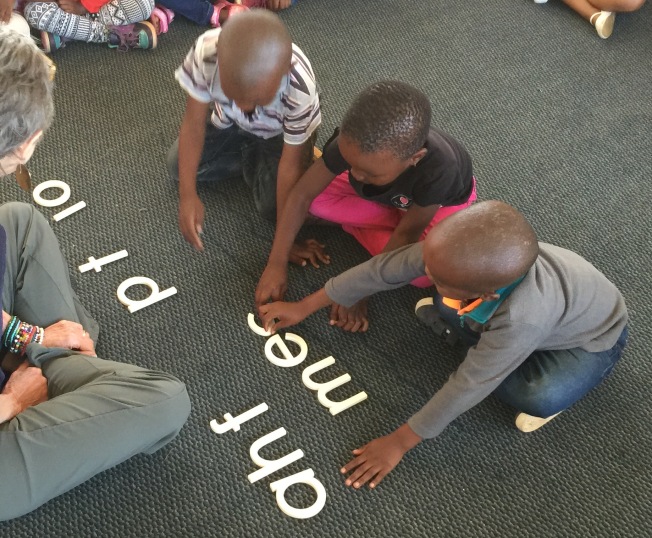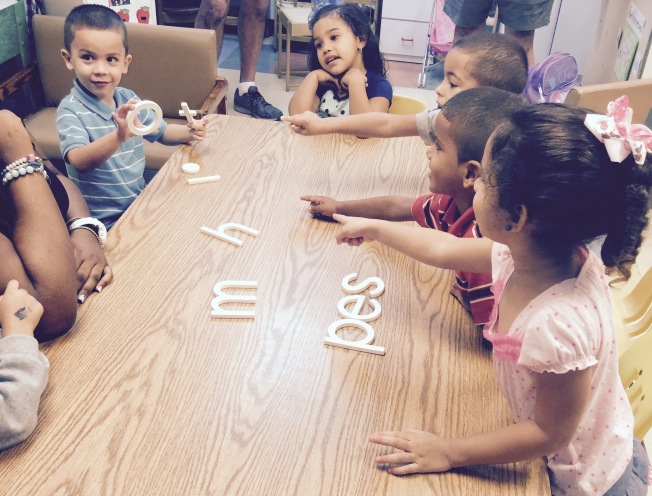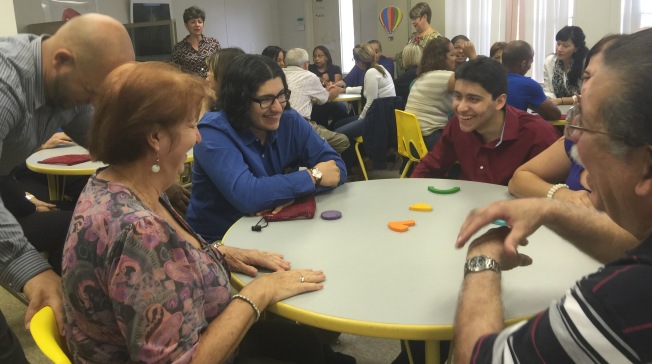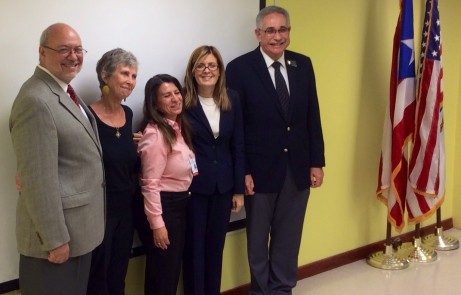
This journey is a small portion of a Rotary global grant sponsored by RD 6900 and RD9400 which is making a dramatic difference for early literacy. As one teacher said, “The children in this program will change the future for South Africa.”
We left Johannesburg just before 10 in the morning, heading north to work with the Peace Corps on a literacy project using Souns. Today is our day to comfortably drive the 5 hours. I have done this trip before. This is the training site where we came without Souns materials once, showing teachers how to do the program with materials at hand….just paper and markers. There were 65 teachers trained, all eager and so glad to have a way to help their learners. I wonder – hope – we have some of those teachers in this training, since now we have Souns to give them.
The drive is beautiful. Expanses of brown grass spotted with low thorn-bush trees. At times it seems you can see forever, soft rolling terrain framed in the distance by a blue strip of hills – koppies. There are occasional cows seen feeding in the grass. There are other animals too…but none spotted yet.

About halfway to our destination we approach the bank of “koppies” and the trees are more varied in color, texture, and height. The thorn bushes hug the ground between taller trees. We just passed a sign for the municipality of Molemole (sound every letter)…..I just love the African languages – they are so musical.
Arrival day brought with it an adjustment to a cold shower and a search for dinner. On Monday morning we went to the local Wimpy for a rendezvous with those in charge of the training, sharing data on the specific training sites to be visited.
The day was as I hoped…eager teacher minds, children to work with, and all in a typical preschool setting. We worked with the classroom of 4-5 year olds. The initial impression of the room was informing…so many plastic square tables and chairs that there was no floor space left. There were no shelves and no materials except for the stack of workbooks and containers of crayons and other supplies for table work. Several charts were on the wall at adult height…something we all discussed later. The teachers and the administration were bright, passionate people wanting to create an excellent school.
We began by working with the children. The classroom had not yet been given Souns materials. The Peace Corps volunteers (PCV’s) gave lessons to the class with their Souns materials each week and asked the teacher to use paper and marker to support the work in between their visits. I began by asking the teacher to do what she would typically do for a whole group lesson. She did the usual – holding up a paper and asking the children to identify the sound written on it. While this is not suggested Souns practice, it was quickly obvious she had been working on teaching the children letter-sound associations, and they were learning.
 I asked to see a small group of children. We used the paper, as they were most familiar with that method. Then I used the actual Souns letters with the children in a typical small group lesson. They each had learned at least two sounds well, and several knew the first four. The teacher was very conservative introducing new letter-sound associations…..very typical of someone new to Souns. We introduced two more sounds – /p/e/. Then I kept two learners and demonstrated building a few simple words on a line. It was a good moment as the learners clearly wanted something harder than they already knew how to do. I suggested learners at this age and with comfort in approaching 10 letter-sound associations needed to build a word each day. As usual, the teacher was surprised at what they could do!
I asked to see a small group of children. We used the paper, as they were most familiar with that method. Then I used the actual Souns letters with the children in a typical small group lesson. They each had learned at least two sounds well, and several knew the first four. The teacher was very conservative introducing new letter-sound associations…..very typical of someone new to Souns. We introduced two more sounds – /p/e/. Then I kept two learners and demonstrated building a few simple words on a line. It was a good moment as the learners clearly wanted something harder than they already knew how to do. I suggested learners at this age and with comfort in approaching 10 letter-sound associations needed to build a word each day. As usual, the teacher was surprised at what they could do!
The day progressed with the children going outside and the adults rounding up to discuss good practice with Souns. I chose to use a new guide booklet to set the pace. This simple version was appreciated by everyone. There was vibrant discussion around several of the pages, which was a very good thing. I believe it was an effective way to engage the group and assimilate the steps of Souns.
The concluding “happy” was an invitation to help with the room….my Montessori heart just smiled. What fun! Everyone worked to remove, reform, and simplify the environment. When we finished there were two plastic “work” tables each with four chairs, an art table against the wall (two plastic tables on top of which was placed a door, previously stored in the adjacent bathroom) with five chairs around it. There was excellent floor space for group work or individual work mats. There was a designated construction corner, a reading corner, and a chalk board space low on the wall for children. The charts were lowered to be in reach of little hands. Progress was made, as this photo was sent to me three days later.

Bidding our farewells and getting a last photo was another opportunity for sharing. We were on the playground in the presence of the greatest chalkboard ever…the red dirt of SA. With children playing freely, I took a little one…one of the two who helped build words and who is a future little “teacher” for the class. We sat on the ground and I drew an /o/ in the soil and gave him a rock to draw an /o/. We were joined by a circle of faces and little hands with rocks drawing “sounds” in the red soil. Many of these learners were not in the class, but were now exposed to letter-sound associations in the purest way possible – child to child. Learning can be so simple…what can we do to unburden the process of learning to read?
 Training on Tuesday, March 10, was the same but different. We drove down a long gravel road to a village that was a classic in my experience in SA rural villages: tiny round or rectangular brick and clay (sometimes metal) structures with thatched or metal roofs. Little yards fenced with curved limbs from trees pinioned to the ground and each other to define the resident space. Mango trees and other greenery dress seemingly swept dirt yards. Earth red, green, sand, and dried thatch color the expanse of little homes…each framed by the dark, dancing, sticks with shadows from the sun that doubled their curls and twists.
Training on Tuesday, March 10, was the same but different. We drove down a long gravel road to a village that was a classic in my experience in SA rural villages: tiny round or rectangular brick and clay (sometimes metal) structures with thatched or metal roofs. Little yards fenced with curved limbs from trees pinioned to the ground and each other to define the resident space. Mango trees and other greenery dress seemingly swept dirt yards. Earth red, green, sand, and dried thatch color the expanse of little homes…each framed by the dark, dancing, sticks with shadows from the sun that doubled their curls and twists.
We arrived at the little preschool and were greeted by the teachers and principal. The two PCV’s introduced us all and showed us around the facility. It was a lovely environment. The classroom was textbook perfect: organized, spacious, children’s personal artwork everywhere, as well as words in Tsonga (w lower case letters) on the wall where little hands could touch.
We adults sat together and trained, role playing teacher and learner, covering the highlights and critical points of Souns. Then it was time for children. We gave five of the little ones, probably three years old, a lesson using paper and marker to show them the first four sounds…/o/m/s/t/. We explained that if the teachers demonstrated the Souns program by teaching the first four letter-sound associations this way, we will give them a Souns set from Rotary after that month. That has been a worthwhile arrangement thus far. Giving a Souns set to a classroom and having it misused or placed on a storage shelf is not a good investment of time or funds. I foresee the leadership in this preschool as committed guardians of the program. (Now to drive back to Pretoria)
Wednesday, day three! This day was a treat of another kind: working with an umbrella organization – PEN – overseeing hundreds of preschool/crèche teachers in Pretoria. They speak English and teach in English, which is easier (for training) than a mixed group with several languages. We introduced Souns to thirty teachers…a few were familiar, but most were new to the program. As there were no Souns sets designated for these teachers yet, I demonstrated how to proceed with the program with paper and markers first. They wanted a way to start immediately…so now they can. The presentation was lively, with good questions, responses, and laughter. I can’t’ wait to revisit this group.
Thursday, day four! We are in Mamelodi visiting two primary schools: one school with four Grade R classrooms and two Grade 1 classrooms using Souns and another school where we focused on four Grade R classrooms. The first school was newer to the program. We visited the two established Souns classrooms and then had a most productive meeting with the two new teachers. These two new teachers were trained initially by colleagues and have done really good work with Souns. Typical of new-to-Souns teachers, the learners were being guided at a slower rate. They had reached about six sounds introduced. We asked for four learners from each of their classrooms and demonstrated how to move forward with more certainty. With two of the more confident learners, I demonstrated building words. The teachers were pleased to see several learners ready for this next stage.
The second school is now in its third year with Souns in Grade R and the experience for me was confirming. I met with two teachers at a time in a private space where we could speak comfortably and uninterrupted. I remember the same faces three years prior obligingly taking on a new program to use on top of others that were not working. Today, the faces spoke a different story. They were leaning forward, eye to eye, sharing their practice (even supporting its value with Souns language), proud of where their learners were so early in the year with their letter-sound knowledge. This was a deeply pleasing arrival point for this work. These teachers were becoming Souns practitioners. Success with the learners built their confidence in their own practice which would grow the legs of sustainability for Souns. I attribute much of the day’s story to good leadership in the schools…teachers need support and these two schools have extraordinary administrative support for their teachers.
At the close of our conversation, I asked each of the teachers if their learners were building words yet. Each exclaimed, “No!” …commenting in their individual ways that they did not think their learners were ready. I suggested that at their age and with 10 sounds known, they likely were. I asked for two learners from each class. The teachers were stunned that the learners moved so quickly to building words. I am glad we visited early in their academic year, a good time to help them know more about the need to keep up with the child. The child will generally move faster than the teacher realizes. They will continue building words – just one or two words each day – and will, no doubt, have some children sounding out words in a few months if not sooner. There are many children in the room ahead of where the teacher thought they were…a very common picture, unfortunately.

Friday, day five! This is the last day of the first week of training, we are visiting two more primary schools in Mamelodi. In the first there were five grade Grade R classrooms. Two of the teachers were new to Souns, but had been guided by the three who were trained in previous years. We visited each classroom, discussing how their children ended last year and how the new class was doing this year. School years in SA begin mid-January and conclude early December. This visit was toward the end of the of the first term. The learners have had 8 weeks of school to get where they are now…!!! It is an impressive effort by the teachers and the learners. One Grade R teacher said, “The learners for Grade R at the end of 2014 were so clever and I was so excited because during the parent ceremony they already knew how to read Grade 1 books.”
The second school visited this day had three Grade R classes with teachers who were experienced with Souns. We visited to ask about progress last year and with the new classrooms of learners this year. As usual, we asked if the children had begun building words. Again, the answer was an immediate “Not yet!” As before, I demonstrated with two of each of their classrooms that they were, indeed, ready to build words by listening to the sounds.
The final training at the last school this week was with Grade 1 teachers. There were five, three of whom have had experience with Souns. The practice in a Grade 1 classroom is not ideal as the numbers are quite different: there are 50-60 learners in each class with one teacher. The pressure on everyone is tremendous. Small groups are not possible, so our approach is for whole class activities that engage the child in listening to and discerning sounds in words. With such discrimination, they will develop attack skills that will serve them well in writing and reading as the year progresses. We went to one classroom and demonstrated some activities to build these skills. One teacher added that she has found the material to be important for challenged learners, “Letters that they can hold in their hand and move around is making a big difference.”
In conclusion, this first week of training confirmed the value of this effort to build fundamental literacy skills for young learners in South Africa. We introduced Souns to new classrooms, new teachers, reviewed experienced Souns practitioners, monitored progress, and demonstrated to all Grade R teachers that their effort to date was farther ahead than they thought. Teachers need to learn to trust their children to be able….surprisingly able…to move well ahead of expectations.

When we return in several months, we expect to see learners in each classroom to be engaged in all the stages of Souns, depending on their inherent ability. All will continue to work on letter-sound associations, most will be building words, and many will be sounding out words or reading.
We have one more week of training in other primary schools and preschools in Pretoria. As always, it will be important to glean our own lessons out of these two weeks for future training.

 n. I am astonished how this program is working with each one of my students. This has given them a boost to their self-esteem. Parents are so grateful, because they never thought that at this stage, their children were able to learn sounds and recognize letters the way they are doing it. The process is slowly but steady, growing each and every day. Now they loved to help each other, and help one to another when someone is struggling with a letter sound. Moreover I am learning a lot during the process and acquiring great knowledge about the fascinating link between the hand and the brain.
n. I am astonished how this program is working with each one of my students. This has given them a boost to their self-esteem. Parents are so grateful, because they never thought that at this stage, their children were able to learn sounds and recognize letters the way they are doing it. The process is slowly but steady, growing each and every day. Now they loved to help each other, and help one to another when someone is struggling with a letter sound. Moreover I am learning a lot during the process and acquiring great knowledge about the fascinating link between the hand and the brain.




 During the trip we also attended several English and Spanish-speaking Rotary Club meetings, providing us the opportunity to exchange club banners and interact with many Rotarians. The Rotarians of District 7000 and their District Governor, Jesus A. Vivas, could not have given us a more welcoming and enthusiastic reception.
During the trip we also attended several English and Spanish-speaking Rotary Club meetings, providing us the opportunity to exchange club banners and interact with many Rotarians. The Rotarians of District 7000 and their District Governor, Jesus A. Vivas, could not have given us a more welcoming and enthusiastic reception.














 I asked to see a small group of children. We used the paper, as they were most familiar with that method. Then I used the actual Souns letters with the children in a typical small group lesson. They each had learned at least two sounds well, and several knew the first four. The teacher was very conservative introducing new letter-sound associations…..very typical of someone new to Souns. We introduced two more sounds – /p/e/. Then I kept two learners and demonstrated building a few simple words on a line. It was a good moment as the learners clearly wanted something harder than they already knew how to do. I suggested learners at this age and with comfort in approaching 10 letter-sound associations needed to build a word each day. As usual, the teacher was surprised at what they could do!
I asked to see a small group of children. We used the paper, as they were most familiar with that method. Then I used the actual Souns letters with the children in a typical small group lesson. They each had learned at least two sounds well, and several knew the first four. The teacher was very conservative introducing new letter-sound associations…..very typical of someone new to Souns. We introduced two more sounds – /p/e/. Then I kept two learners and demonstrated building a few simple words on a line. It was a good moment as the learners clearly wanted something harder than they already knew how to do. I suggested learners at this age and with comfort in approaching 10 letter-sound associations needed to build a word each day. As usual, the teacher was surprised at what they could do!
 Training on Tuesday, March 10, was the same but different. We drove down a long gravel road to a village that was a classic in my experience in SA rural villages: tiny round or rectangular brick and clay (sometimes metal) structures with thatched or metal roofs. Little yards fenced with curved limbs from trees pinioned to the ground and each other to define the resident space. Mango trees and other greenery dress seemingly swept dirt yards. Earth red, green, sand, and dried thatch color the expanse of little homes…each framed by the dark, dancing, sticks with shadows from the sun that doubled their curls and twists.
Training on Tuesday, March 10, was the same but different. We drove down a long gravel road to a village that was a classic in my experience in SA rural villages: tiny round or rectangular brick and clay (sometimes metal) structures with thatched or metal roofs. Little yards fenced with curved limbs from trees pinioned to the ground and each other to define the resident space. Mango trees and other greenery dress seemingly swept dirt yards. Earth red, green, sand, and dried thatch color the expanse of little homes…each framed by the dark, dancing, sticks with shadows from the sun that doubled their curls and twists.

 It is early morning and I am in a winter wonderland, snowed in and free to revisit the past few days in Colorado Springs, Colorado. Smiles, excitement, hope: a myriad of positive emotions and shared experiences as the Souns trainings and visits unfold.
It is early morning and I am in a winter wonderland, snowed in and free to revisit the past few days in Colorado Springs, Colorado. Smiles, excitement, hope: a myriad of positive emotions and shared experiences as the Souns trainings and visits unfold.



